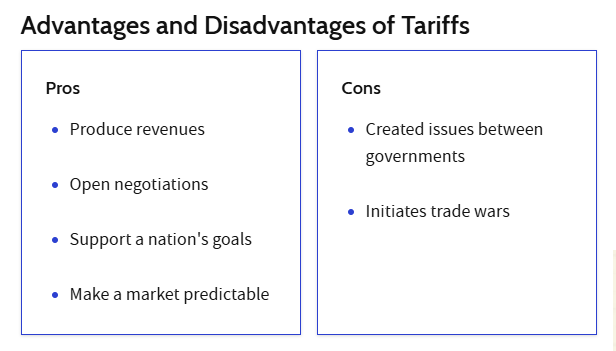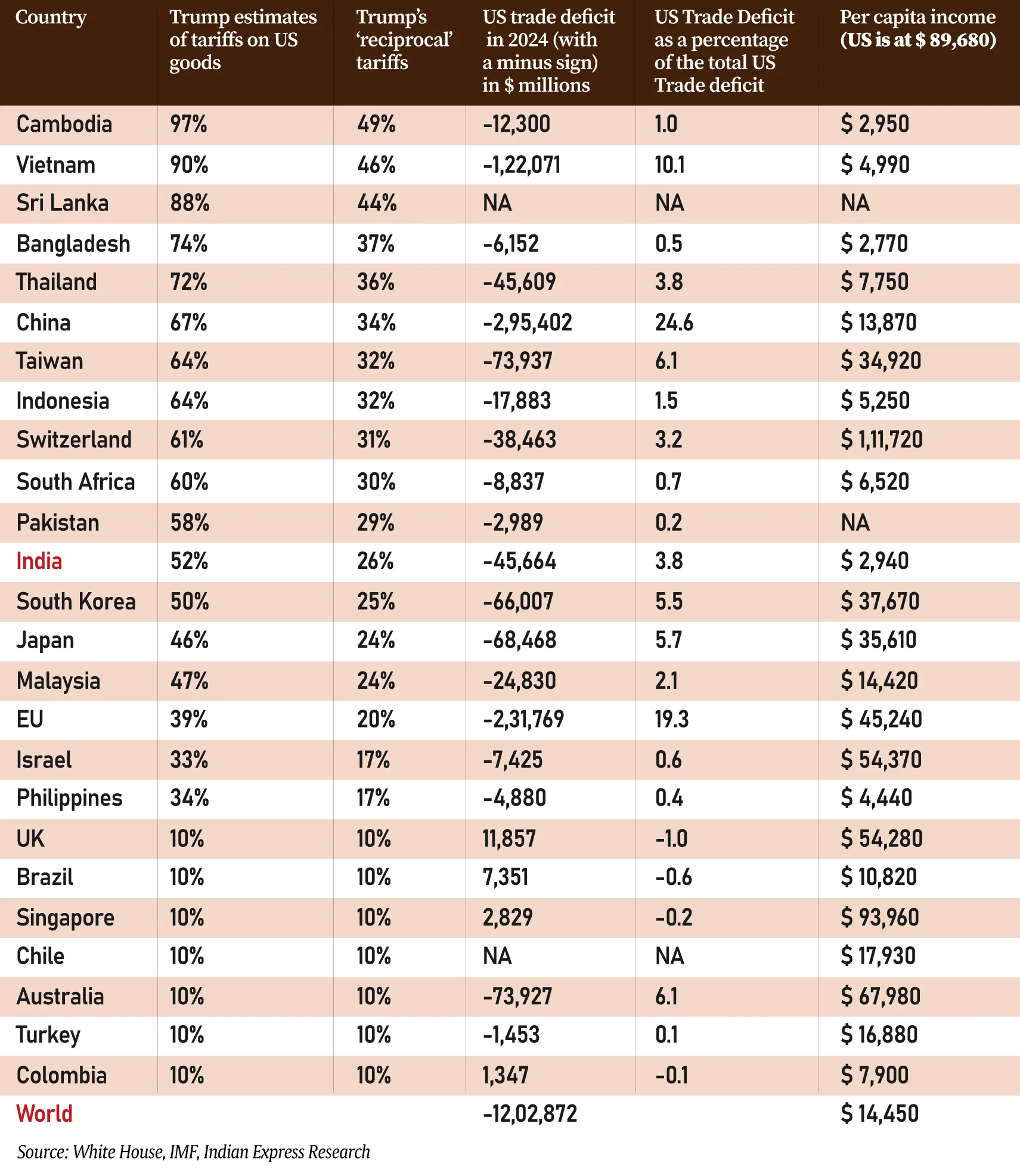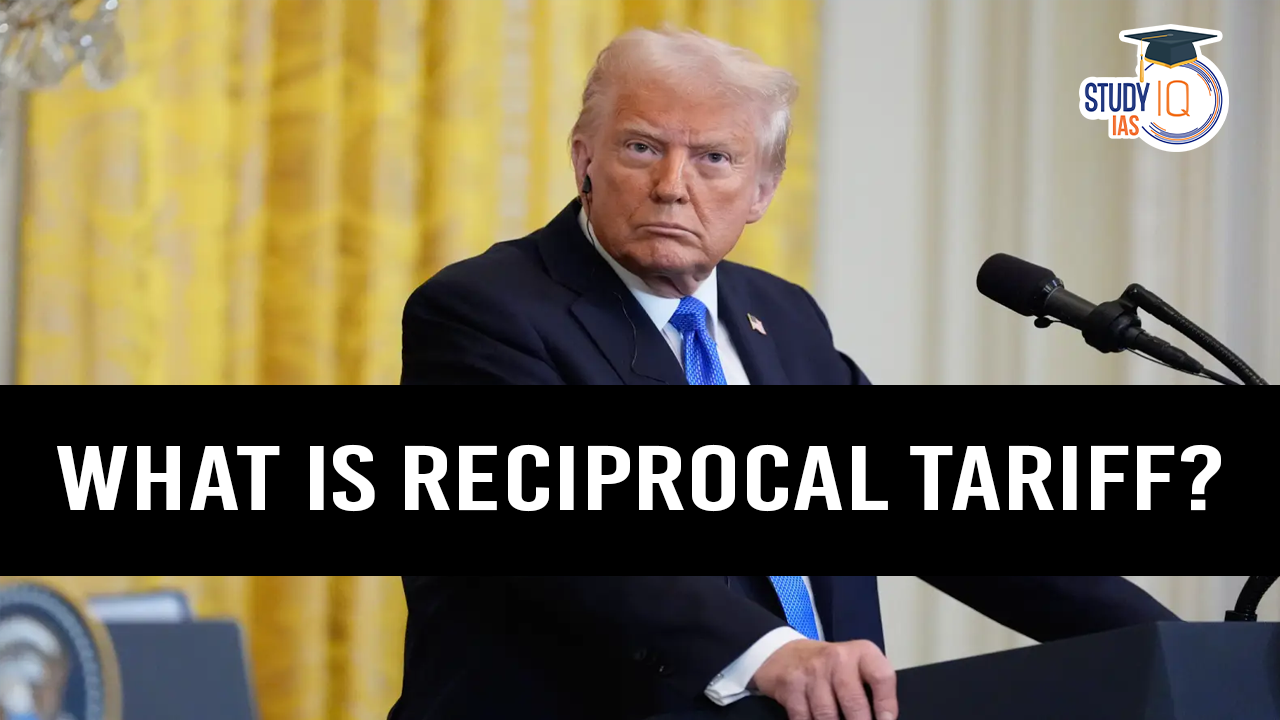Table of Contents
Context: President Donald Trump’s announcement of new reciprocal tariffs—currently set at 10% for most countries for a 90-day period—is intended to address U.S. trade imbalances and carries notable implications for India.
US President Donald Trump celebrated America’s “Liberation Day” on April 2 by announcing “reciprocal tariffs” against all major trading partners. On April 2, 2025, U.S. President Donald Trump announced a 26% reciprocal tariff on Indian imports. This decision is part of a broader strategy to address perceived trade imbalances. It follows similar measures against other nations, including a 34% tariff on Chinese goods and a 20% tariff on European Union imports.
More in News
There were two sets of tariffs announced.
- A base tariff of 10% against all countries (Earlier 2.5%).
- Country-specific tariffs.
Reciprocal Tariffs Meaning
A reciprocal tariff is a tax or trade restriction imposed by one country in response to similar actions taken by another. The goal is to create a balance in trade between nations by ensuring fairness in tariff rates. While intended to protect local industries, reciprocal tariffs can lead to trade wars and economic disruptions.
- Eg., if Country A charges a 10% tariff on imports from Country B, then Country B might also charge a 10% tariff on imports from Country A.
What is a Tariff?
A tariff is a tax imposed by one country on the goods and services imported from another country to raise revenue, protect domestic industries, or exert political leverage over another country.

Historical Context
Since World War II, global trade has moved towards freer trade agreements. Agreements like GATT (General Agreement on Tariffs and Trade) and the WTO (World Trade Organization) ensured that developing countries received preferential treatment. Under this system, developing nations could levy higher tariffs to protect their industries, while developed nations maintained lower tariffs.
However, President Trump’s approach seeks to end the preferential treatment of developing nations. Under his policy, the U.S. will now match tariff levels of other countries on American exports. Trump calls this a “fair” system where the U.S. no longer has to worry about uneven tariffs.
Use code “BLOG“ to Avail of “20% OFF“ Applicable on All Courses Including Books & Test Series
Trump Tariffs on India: Sector-Wise Impact on Indian Exports
The 26% tariff is expected to have varying effects across different sectors of the Indian economy:
Pharmaceuticals
- India exports approximately $9 billion worth of pharmaceuticals to the U.S. annually.
- The pharmaceutical sector is a major contributor to India’s economy, with top companies such as Sun Pharma, Dr. Reddy’s, and Cipla playing a crucial role in U.S. drug supply chains.
- Notably, the Indian pharmaceutical industry has been spared from these tariffs, providing relief to exporters.
- Following the announcement, shares of Indian drugmakers surged by nearly 5%, indicating positive market sentiment.
Electronics and Gems & Jewellery
- India’s electronics exports, particularly mobile phones and semiconductors, have grown significantly due to government incentives under the PLI (Production-Linked Incentive) scheme.
- The U.S. is a major destination for India’s gems and jewellery exports, which stood at over $10 billion in 2024.
- Increased tariffs could raise costs, making Indian products less competitive in the U.S. market.
- Indian exporters may shift their focus towards alternative markets, such as the UAE and the European Union, to offset losses.
Automobiles and Auto Parts
- The U.S. has imposed a 25% tariff on all imported automobiles.
- Indian automakers such as Tata Motors and Mahindra, which have growing footprints in the U.S. electric vehicle market, could be affected.
- Rising input costs may force manufacturers to reconsider their pricing strategies, potentially leading to job losses in the sector.
IT and Software Services
- The U.S. is the largest market for India’s IT sector, with exports exceeding $150 billion annually.
- While software services are not directly affected by tariffs, visa restrictions and potential trade tensions could impact outsourcing agreements.
- Major IT firms like TCS, Infosys, and Wipro may face increased regulatory scrutiny.
India’s Position in the Global Context
While the 26% tariff is substantial, it is still lower than the duties imposed on other Asian countries.
- China faces tariffs exceeding 50%, and Vietnam is subjected to a 46% tariff.
- This suggests that India might retain a degree of competitiveness in the U.S. market relative to its regional peers.
Additionally, India’s push towards self-reliance (Atmanirbhar Bharat) and trade diversification strategies may help mitigate long-term risks.
Potential Responses and Strategic Considerations
To mitigate the impact of these tariffs, the Indian government may explore several strategies:
- Negotiations – Engaging in diplomatic discussions with the U.S. to seek reductions or exemptions in certain areas.
- Tariff Adjustments – Consider lowering tariffs on U.S. imports to foster goodwill and potentially prompt reciprocal actions.
- Diversification – Expanding export markets to reduce reliance on the U.S. and mitigate the impact of these tariffs.
- Strengthening Domestic Industries – Encouraging local production and consumption to lessen dependency on exports.
- Leveraging Trade Agreements – Strengthening trade partnerships with the European Union, ASEAN, and Middle Eastern nations.
Economic and Market Implications
- The Indian stock market witnessed fluctuations following the tariff announcement, with key indices reacting to sector-specific impacts.
- The Indian rupee could face depreciation pressure as foreign exchange inflows from exports decline.
- Small and medium-sized enterprises (SMEs) dependent on the U.S. market may require government support to sustain operations.
Reasons Behind Imposing Reciprocal Tariffs
- To Encourage Domestic Manufacturing: Reciprocal tariffs are intended to make imported goods more expensive, thereby incentivizing companies to shift their production facilities to the United States.
- Job Creation and Wage Growth: By promoting local production, the administration aims to create more employment opportunities within the country and potentially increase wages for American workers.
- As a Negotiating Tactic: The tariffs serve as a pressure tool to push other countries into trade negotiations.
- Counter Unfair Trade Practices: The U.S. administration suggests that tariffs may be reduced or eliminated if trading partners agree to remove what are considered unfair trade practices or reduce trade imbalances.
- To Address Trade Deficits: The tariffs are also aimed at reducing the U.S. trade deficits with specific countries. By discouraging imports and encouraging exports, the policy seeks to rebalance trade flows.

What Can Be the Responses from Other Countries to US Reciprocal Tariffs
Retaliation
Imposing similar or higher duties on US goods and services.
- Eg., China responded by imposing 34% tariffs on all imports of US goods.
- Challenges:
- Economically harmful — mimics the same negative effects as the US tariffs.
- Only large economies like India, China, or the EU can make a significant dent in US exports.
- May provoke further escalation by the US (e.g., tariffs on critical sectors like pharma or semiconductors).
- Politically ineffective, as the current US administration views withdrawal as a sign of weakness.
Re-orienting Exports & Finding New Markets
Diversifying export destinations to reduce dependency on the US.
- Strategies: Market research and new trade partnerships.
- Speed up trade agreements like:
- AfCFTA (Africa)
- EU-Mercosur Agreement
- India–Sri Lanka FTA
- Negotiating with the US: Countries may adjust their own MFN (Most Favoured Nation) tariffs or trade policies to align with US expectations.
- Countries like Bangladesh, Sri Lanka, or Fiji may reduce their tariffs on US goods.
Structure and Calculation of Reciprocal Tariffs
- Uniform Country-Based Tariff: A standardised tariff is imposed on all goods from a specific country, in addition to existing commodity-specific tariffs.
- Tariff Calculation Formula: The formula used to determine the discounted tariff rate is:
Discounted Tariff Rate = (-1) × (½) × (U.S. exports – U.S. imports) / U.S. imports
This method ignores factors like price elasticity and specific duties, potentially leading to a misleading representation. - Distorted Rate Presentation: A column labelled ‘charged to the US’ doubles the calculated discounted rate, which further skews the actual impact.
- India-Specific Tariff (2024): Based on 2024 trade data (U.S. exports to India: $41.8 billion; imports from India: $87.4 billion), India’s reciprocal tariff rate is calculated at 26%.
- Add-On to Existing Tariffs: This reciprocal tariff is applied over and above existing tariffs, with exemptions for certain sectors such as:
- Pharmaceuticals
- Steel and aluminium articles
- Automobiles and auto components
- Copper, energy products, semiconductors, bullion, and select critical minerals
- Default Rate for Other Countries: Nations not listed under the reciprocal tariff scheme will face a default tariff rate of 10%.
Impact on Indian Exports to the USA
- Moderate Export Dependence: India’s reliance on exports is moderate, and shipments to the U.S. have been on a decline. Therefore, the overall economic impact of the 26% tariff is expected to be limited but will vary across sectors.
- Sectors Likely to Be Hit: Key Indian exports that may face pressure include:
- Electrical machinery
- Machinery and mechanical appliances
- Made-up textile articles
- Sectors Less Affected:
- Gems and jewellery: Likely to remain stable due to inelastic demand.
- Pharmaceuticals: Exempt from the new tariff measures.
- Comparative Advantage: India retains a relative edge as competitor nations like China, Vietnam, and Bangladesh face steeper reciprocal tariffs. South Korea faces a similar tariff rate of 25%.
Recommended Indian Response
- Avoid Aggressive Retaliation: India should refrain from aggressive countermeasures like China, which triggered steep retaliatory U.S. tariffs (up to 245% on some goods).
- Adopt a Balanced, Strategic Approach: A multi-pronged response is advised:
- Boost U.S. Imports: Increasing imports from the U.S. can help reduce India’s reciprocal tariff burden.
- Eg., Redirecting $25 billion in oil imports to the U.S. could lower the tariff from 26% to 11.8%, just above the default 10% threshold.
- Engage in Trade Talks: Proactively initiate trade consultations with the U.S. to negotiate a mutually beneficial long-term agreement.
- Boost U.S. Imports: Increasing imports from the U.S. can help reduce India’s reciprocal tariff burden.
- Watch for Dumping: Closely monitor imports from heavily impacted countries like China, which may resort to dumping surplus goods in India at lower prices.
Impact of Reciprocal Tariffs on the Global Economy
- Disruption of Global Trade: Reciprocal tariffs disrupt established global supply chains, increase costs for producers and consumers, and reduce trade volumes.
- Eg., Countries like Vietnam, Bangladesh, Cambodia, and Sri Lanka face steep tariffs (up to 54%) on key exports such as garments and footwear. These nations heavily rely on the US market for over 25% of their exports.
- Shift in US Import Sources (Trade Diversion): Countries with preferential trade access to the US — such as Kenya, Ethiopia (under AGOA), and Nicaragua (via CAFTA-DR) — may gain market share as US buyers shift away from high-tariff Asian suppliers.
- Increased Inflation: Tariffs raise the price of imported goods, causing inflationary pressures in both importing and exporting countries.
- In the US: Consumers pay more for goods like electronics, clothing, and auto parts.
- Globally: Countries affected by a weaker currency due to retaliatory tariffs may face costlier imports, especially of essentials like crude oil.
- Risk of Stagflation: When high inflation is coupled with stagnant or negative growth — known as stagflation — it creates a particularly difficult policy challenge.
- Central banks may struggle to manage inflation without worsening unemployment or stalling growth further.
- Investment sentiment weakens, further hurting growth.
- Uncertainty and Investor Pullback: Tariff wars introduce uncertainty in global markets, deterring long-term investment.
- Stock markets may dip due to an uncertain earnings outlook.
- Firms delay expansion plans or hiring due to unpredictable trade policy environments.
- Shift in Global Alliances and Trade Blocs: Reciprocal tariffs may accelerate the formation of alternative trade blocs or the strengthening of regional ties.
- EU and Asia might align more closely to reduce reliance on the US market.
- India and ASEAN could emerge as more significant partners in global supply chains if they maintain lower trade barriers.
- Potential for Currency Wars: To offset tariff impacts, countries might devalue their currencies intentionally to maintain export competitiveness.
- Result: Competitive devaluation could lead to currency instability, capital flight, and economic shocks in emerging markets.
What are the Opportunities For India?
| Opportunity Area | Description |
| Relative Tariff Advantage | India faces a 26% tariff, which is lower than China (54%), Vietnam (46%), and Bangladesh (37%) — boosting competitiveness in sectors like textiles and garments. |
| Value-Added Manufacturing | Encourages Indian exporters to focus on quality, innovation, and branding to justify higher prices in global markets. |
| Trade Diversification | Pushes India to explore alternate export markets like the EU, ASEAN, Africa, and the Middle East. |
| Supply Chain Realignment | India can attract global manufacturers looking to diversify away from China (China+1 strategy). |
| MSME Sector Upgradation | Tariff pressure can lead to formalisation, digital transformation, and productivity boosts in MSMEs. |
| Strategic Diplomacy | Leverage the situation to negotiate better terms in Indo-US trade, services, and investment frameworks. |


 Growth in Gold Loans and NPAs, Reasons a...
Growth in Gold Loans and NPAs, Reasons a...
 How RBI Responded To Global Trade War Ch...
How RBI Responded To Global Trade War Ch...
 Why Confidence in US Dollar is Falling?
Why Confidence in US Dollar is Falling?





















